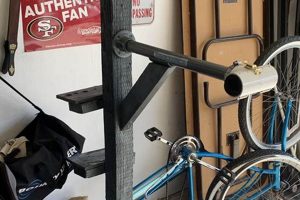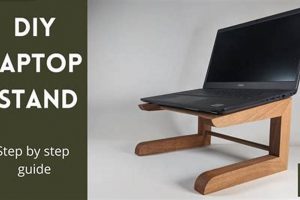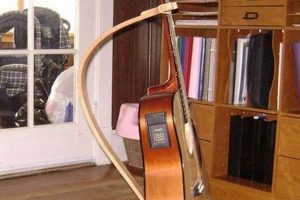A self-constructed mounting platform for a vise provides a stable and adaptable workstation. This structure typically involves fabricating a base and upright support, often using materials like steel tubing or lumber, to elevate and secure a vise at a comfortable working height. A common example is welding together steel pipes to create a tripod base with a flat top plate for bolting the vise.
The advantages of such a build include enhanced portability and space efficiency compared to permanently mounted vises. Furthermore, cost savings are realized through the use of readily available materials and avoidance of purchasing a commercially manufactured stand. Historically, resourceful craftsmen have employed similar techniques to customize their work environments, adapting tools and equipment to meet specific needs and limitations.
The following sections will explore various design considerations, construction techniques, and material options for creating a custom support structure for a bench vise. Specific attention will be given to ensuring stability, durability, and ergonomic design for optimal usability in a variety of workshop settings.
Tips for Constructing a Stable Vise Mounting Platform
The following guidelines are essential for creating a robust and functional self-made support structure for a bench vise. Adhering to these principles will ensure safety and optimal performance during operation.
Tip 1: Prioritize Base Stability: A wide and sturdy base is crucial. Employ a tripod or square design, ensuring the footprint sufficiently exceeds the vise’s dimensions. For example, a vise with a 6-inch jaw width should have a base at least 18 inches wide.
Tip 2: Select Appropriate Materials: Steel offers superior strength and durability compared to wood. When using steel, consider schedule 40 steel pipe or equivalent. If wood is preferred, opt for hardwood such as oak or maple, with a minimum thickness of 2 inches.
Tip 3: Ensure Proper Vise Mounting: Use high-strength bolts (grade 8 or higher) and washers to securely fasten the vise to the mounting plate. Countersink the bolt heads to prevent interference with the vise’s operation. A properly mounted vise will not shift or vibrate excessively during use.
Tip 4: Consider Height Ergonomics: Determine the optimal height for the mounting platform based on the primary user’s stature and typical applications. A height that allows the user to maintain a comfortable posture, minimizing strain on the back and shoulders, is essential.
Tip 5: Implement Vibration Dampening: Add rubber feet or pads to the base to absorb vibrations and prevent the structure from moving during use. This also reduces noise transmission to the surrounding environment.
Tip 6: Reinforce Stress Points: Reinforce joints and connections with gussets or welding to enhance structural integrity. Pay particular attention to the connection between the upright support and the base, as this area is subject to significant stress.
Tip 7: Apply a Protective Coating: Apply a durable coating, such as paint or powder coating, to protect the metal from rust and corrosion. This extends the lifespan of the structure and maintains its aesthetic appeal.
By adhering to these guidelines, a durable and functional support platform can be constructed, providing a stable and efficient workstation for a variety of tasks.
The subsequent sections will address specific design considerations and detailed construction techniques for creating a custom support structure.
1. Stability
Stability is a paramount concern in the design and construction of a self-made mounting platform. The inherent function of a vise requires it to withstand significant forces; consequently, the support structure must provide unwavering stability to ensure user safety and effective operation.
- Base Footprint and Geometry
The footprint of the base directly influences stability. A wider base, whether tripod or square, provides a greater resistance to tipping forces. For instance, a tripod base distributes weight evenly, while a square base offers maximum surface contact. The geometry of the base should be designed to counteract the potential for movement during vise operation, such as hammering or material bending.
- Material Rigidity and Mass
The choice of material significantly affects the rigidity and mass of the structure. Steel, due to its high tensile strength and density, offers superior stability compared to wood. A heavier structure resists movement more effectively. For example, a mounting platform constructed from thick-walled steel tubing will inherently be more stable than one made from thinner, lighter materials.
- Joint Integrity and Reinforcement
The points where different components of the structure connect are critical to overall stability. Welded joints in steel structures provide a rigid and permanent connection. In wooden structures, robust joinery techniques, such as mortise and tenon or bolted connections with reinforcement plates, are essential. Any play or weakness in these joints will compromise the stability of the entire platform.
- Vibration Dampening and Ground Contact
Vibration can destabilize the structure and transmit noise. Implementing vibration-dampening measures, such as rubber feet or pads, helps to absorb impact and reduce movement. Ensuring solid ground contact is also crucial. An uneven surface can introduce instability; therefore, adjustable feet are beneficial for adapting to varying floor conditions.
These interconnected factors underscore the importance of careful planning and execution in the construction of a stable vise mounting platform. A failure to adequately address any of these aspects can result in a hazardous and inefficient workstation.
2. Materials
The selection of materials is intrinsically linked to the functionality, durability, and overall success of any self-constructed vise support structure. The properties inherent in each material dictate the platform’s ability to withstand applied forces, resist environmental degradation, and maintain structural integrity over time. For instance, using mild steel tubing for the framework provides a balance of strength and weldability, crucial for withstanding the stresses imparted during vise operation. Inadequate material selection can directly lead to structural failure, rendering the entire platform unusable and potentially hazardous.
Considerations extend beyond simple strength. For example, if the mounting platform is intended for outdoor use, resistance to corrosion becomes paramount. In such cases, galvanized steel or powder-coated surfaces become necessary to prevent rust and extend the lifespan of the structure. Alternatively, while wood offers a readily available and often more cost-effective option, its susceptibility to moisture, warping, and insect infestation necessitates careful selection of hardwood species and appropriate sealing or protective treatments. A platform constructed from untreated pine in a humid environment will degrade rapidly, highlighting the direct correlation between material properties and performance.
Ultimately, the optimal material choice reflects a balance between cost, availability, intended use, and required durability. While steel provides superior strength and longevity, wood offers ease of workability and a more forgiving aesthetic. Understanding the inherent properties of various materials and their impact on the structural performance of the support is essential for achieving a safe, functional, and enduring outcome. The success is dependent on a knowledgeable decision of the material chosen.
3. Ergonomics
Ergonomic design principles are crucial to a self-constructed vise mounting platform, influencing user comfort, safety, and productivity. An inappropriately designed structure can lead to musculoskeletal strain and reduced work efficiency. The height of the vise, for example, directly affects the user’s posture. A vise positioned too low necessitates excessive bending, increasing the risk of lower back pain. Conversely, a vise positioned too high can cause shoulder and neck strain. Optimal vise height typically corresponds to the user’s elbow height when standing, allowing for a neutral spine posture during most operations.
Furthermore, the accessibility and arrangement of tools and materials around the self-made platform significantly impact workflow. A poorly organized workspace can lead to unnecessary reaching and twisting, increasing the likelihood of injury. Implementing features such as integrated tool storage or adjustable shelves can improve accessibility and reduce physical strain. Consider a metalworker who frequently uses a hammer and chisel. If these tools are stored within easy reach of the vise, the worker can maintain a stable posture and avoid repetitive, awkward movements. Conversely, if the tools are stored across the workshop, each task becomes more physically demanding, thereby negatively impacting the worker’s productivity and increasing the risk of injury.
In conclusion, incorporating ergonomic considerations into the design of a customized vise structure enhances both the user’s well-being and the efficiency of work performed. While initial construction may require additional planning and effort, the long-term benefits in terms of reduced strain, improved comfort, and increased productivity justify the investment. Challenges such as limited space or budget constraints can be overcome through careful design and resourcefulness, demonstrating that ergonomic principles can be successfully integrated into the construction of a self-made vise support platform.
4. Mounting
The method of securing a vise to a self-constructed mounting platform is critical for functionality and safety. Proper mounting ensures the vise remains stable under load, preventing movement or detachment that could lead to inaccurate work or injury. The connection between the vise and its support must be robust and appropriately engineered for the anticipated forces.
- Bolt Selection and Placement
The type and arrangement of bolts used to secure the vise are paramount. High-strength bolts, typically grade 8 or higher, are recommended to withstand the shear and tensile forces generated during vise operation. The number and placement of bolts should correspond to the mounting holes on the vise base, distributing the load evenly. For instance, a vise with four mounting holes should utilize all four, arranged symmetrically, to prevent stress concentrations.
- Surface Preparation and Interface
The surface where the vise contacts the mounting platform must be prepared to ensure a secure and flush fit. Any irregularities or gaps between the vise base and the platform can introduce instability and increase stress on the bolts. Machining or grinding the surface to create a level interface is essential. The use of a steel backing plate, welded or bolted to the platform, provides a rigid and durable mounting surface.
- Thread Engagement and Locking Mechanisms
Adequate thread engagement between the bolts and the mounting platform is crucial for preventing thread stripping. The length of the bolts should be chosen to maximize thread engagement without protruding excessively. Locking mechanisms, such as lock washers or nylon locking nuts, prevent the bolts from loosening over time due to vibration. These mechanisms are essential for maintaining a secure connection in demanding applications.
- Weld Integrity (for welded mounts)
If the mounting involves welding the vise directly to the platform (generally not recommended for vise longevity), the integrity of the welds is paramount. Full penetration welds using appropriate welding techniques are required to ensure a strong and durable bond. The weld should be inspected for defects, such as porosity or cracking, which can weaken the connection and lead to failure under load. This is usually reserved for specialized applications and should be performed by qualified welders.
Collectively, these factors underscore the importance of meticulous attention to detail during the mounting process. A properly mounted vise provides a stable and safe workstation, enhancing the precision and efficiency of various tasks. Deviations from recommended practices can compromise the integrity of the mounting system and create a potentially hazardous work environment. A well-mounted vise will enhance the utility of the diy vise stand.
5. Durability
Durability is a fundamental consideration in the construction of a self-made vise support platform. The operational demands placed on the structure require it to withstand sustained loads, impacts, and environmental stressors without compromising structural integrity. An inadequate focus on durability can result in premature failure, necessitating frequent repairs or replacements, thereby negating the cost-effectiveness and convenience that a self-constructed solution aims to provide.
- Material Selection and Longevity
The choice of materials directly dictates the lifespan of the platform. Steel, particularly when treated with a protective coating, offers superior resistance to corrosion and deformation compared to wood. For instance, a support constructed from schedule 40 steel pipe, properly welded and painted, can withstand years of heavy use in a workshop environment. Conversely, a wooden structure, even if constructed from hardwood, is susceptible to moisture damage, insect infestation, and eventual decay. The appropriate selection ensures an extended service life of the vise support. The material choice should reflect considerations for the longevity and durability of the stand.
- Joint Integrity and Reinforcement Techniques
The connections between individual components of the mounting platform are critical points of stress concentration. Utilizing robust joinery techniques, such as full penetration welds for steel structures or mortise and tenon joints reinforced with fasteners for wooden structures, ensures the connections can withstand sustained loads. Reinforcing these joints with gussets or bracing further enhances their resistance to deformation and failure. An example would be adding welded gussets to the base of a steel pipe support to prevent buckling under heavy loads.
- Protective Coatings and Environmental Resistance
The application of protective coatings, such as paint, powder coating, or galvanization, shields the structure from environmental degradation. These coatings prevent corrosion, oxidation, and other forms of material deterioration that can compromise structural integrity over time. A powder-coated steel mounting platform, for example, will resist rust and maintain its aesthetic appeal for many years, even in humid or corrosive environments. Consideration should be given to environmental conditions when choosing construction materials.
- Design for Fatigue and Load Capacity
The design of the self-made support should account for the anticipated loads and the potential for fatigue failure. Over-engineering the structure, by using thicker materials or incorporating additional support members, can increase its resistance to fatigue and prolong its lifespan. A mounting platform designed to support a 6-inch vise should be capable of withstanding forces significantly greater than those typically generated during normal vise operation, providing a margin of safety and ensuring long-term durability.
Collectively, these facets of durability underscore the importance of careful planning and execution in the construction of a self-made vise support platform. Addressing each of these aspects contributes to a longer lifespan and increased operational efficiency. A durable vise stand will provide reliable performance and represent a worthwhile investment of time and resources. The durability of the project is a key consideration.
6. Portability
Portability, in the context of a self-constructed vise support platform, refers to the ability to easily move or transport the structure from one location to another. This attribute is particularly valuable in workshops with limited space or in situations where the vise is needed at different job sites. The design and materials used directly influence the degree of portability achievable.
- Weight and Material Selection
The overall weight of the structure is a primary determinant of portability. Lighter materials, such as aluminum or thin-walled steel tubing, reduce the burden of transportation. However, a trade-off exists between weight and stability. A platform constructed from heavy-gauge steel will be more stable but less portable. For example, a vise support made from aluminum tubing might be easily carried but could be less suitable for heavy-duty applications.
- Disassembly and Modular Design
A modular design that allows for easy disassembly into smaller components enhances portability. This can be achieved through the use of bolted connections or quick-release mechanisms. A support structure that can be broken down into manageable pieces is significantly easier to transport in a vehicle or carry up stairs. For instance, a tripod base that detaches from the vise mounting plate allows for separate transport and easier handling.
- Integrated Transport Mechanisms
Incorporating transport mechanisms, such as wheels or handles, directly into the design can improve portability. Wheels allow the structure to be rolled across a workshop floor, while handles provide a convenient grip for lifting. The size and placement of these mechanisms should be carefully considered to ensure balance and ease of use. A vise support with built-in casters, for instance, can be easily repositioned without requiring complete disassembly.
- Size and Footprint
The overall size of the platform, particularly its footprint, affects its maneuverability in confined spaces. A compact design allows the support to be easily moved through doorways or stored in tight locations. A larger footprint, while providing greater stability, can hinder portability. A self-constructed support designed for a small vise can be compact, enhancing movement and placement in smaller shops or even temporary locations.
The successful integration of portability into a self-constructed vise support requires a careful balance between weight, stability, and ease of transport. Design features such as modularity and integrated transport mechanisms can significantly enhance portability, making the structure more versatile and adaptable to various work environments. A portable vise stand is a valuable addition to any workshop.
7. Cost-Effectiveness
The economic advantages of a self-constructed vise support platform stem from the potential to reduce capital expenditure and leverage existing resources. The primary driver of cost savings is the avoidance of purchasing commercially manufactured stands, which often include markups for labor, materials, and distribution. A self-made platform, conversely, allows for the selective acquisition of materials, frequently at lower costs through salvage yards, online marketplaces, or existing workshop inventory. For instance, a craftsman might utilize scrap steel tubing from a previous project and discarded hardwood planks to construct a functional and stable support, effectively minimizing material costs. This approach, however, necessitates a commensurate investment of time and labor; the value of these inputs must be considered when assessing overall cost-effectiveness. The success of this plan is to get the best stand for the lower price.
Furthermore, the opportunity for customization presents a secondary avenue for cost optimization. Commercially available vise stands are often designed to cater to a broad range of applications, potentially including features that are unnecessary for a specific user. A self-constructed platform can be tailored to meet precise requirements, eliminating the need to pay for superfluous functionalities. For example, a woodworker who primarily utilizes a vise for light-duty tasks might opt for a lighter-weight, less expensive wooden platform, rather than a heavy-duty steel stand designed for metalworking applications. This targeted approach ensures that resources are allocated efficiently, maximizing value for the intended use. The importance of value should never be overlooked.
In summation, the economic benefits of a self-constructed vise support hinge on the judicious selection of materials, efficient utilization of labor, and precise tailoring to specific needs. While challenges may arise in accurately quantifying the value of time invested, the potential for significant cost savings, coupled with the opportunity for customization, renders this approach an attractive option for resourceful individuals seeking to optimize their workshop equipment expenditures. This project may be a value add on your workshop.
Frequently Asked Questions
This section addresses common inquiries and concerns regarding the design, construction, and utilization of self-made vise support platforms. The information provided is intended to offer clarity and guidance based on established engineering principles and practical considerations.
Question 1: What are the primary safety considerations when constructing a “diy vise stand”?
Structural stability, material strength, and secure vise mounting are paramount. The platform must withstand anticipated loads without deformation or risk of tipping. Welding should be performed by qualified individuals, and proper personal protective equipment should be worn at all times.
Question 2: Which materials are most suitable for a robust “diy vise stand”?
Steel is generally preferred due to its high tensile strength and weldability. Schedule 40 steel pipe or structural steel tubing offers a good balance of strength and cost. Hardwoods, such as oak or maple, may be used for lighter-duty applications, but require careful selection and treatment to prevent degradation.
Question 3: How can the stability of a “diy vise stand” be maximized?
A wide base footprint, a low center of gravity, and rigid construction techniques are essential. A tripod or square base design provides inherent stability. Reinforcing joints with gussets or bracing further enhances structural integrity.
Question 4: What is the optimal height for a “diy vise stand”?
The ideal height is typically at or slightly below elbow height for the primary user when standing. This minimizes strain on the back and shoulders. An adjustable-height design offers greater versatility to accommodate multiple users or varying tasks.
Question 5: How should the vise be securely mounted to a “diy vise stand”?
High-strength bolts (grade 8 or higher) with appropriate washers are recommended. The bolt pattern should match the mounting holes on the vise base, distributing the load evenly. A steel backing plate can reinforce the mounting surface and prevent deformation.
Question 6: What steps can be taken to prevent corrosion on a “diy vise stand”?
Applying a protective coating, such as paint, powder coating, or galvanization, is crucial. These coatings create a barrier against moisture and other corrosive elements. Regular inspection and maintenance are also recommended to identify and address any signs of corrosion early on.
In summary, the construction of a safe and effective self-made vise support platform requires careful planning, attention to detail, and adherence to established engineering principles. By addressing these frequently asked questions, prospective builders can make informed decisions and avoid common pitfalls.
The subsequent section will explore specific design examples and case studies of successful self-constructed vise mounting platforms.
Conclusion
The preceding discourse has explored various facets of the self-constructed vise support platform. Key points have included stability, material selection, ergonomic design, mounting techniques, durability considerations, portability options, and cost-effectiveness analyses. The importance of adhering to sound engineering principles and safety practices throughout the design and construction processes has been consistently emphasized.
The information presented serves as a foundational resource for individuals seeking to create a customized and functional support structure for a bench vise. Careful planning and execution are essential for ensuring long-term utility and minimizing potential risks. The pursuit of such projects demands diligence and a commitment to quality craftsmanship.







